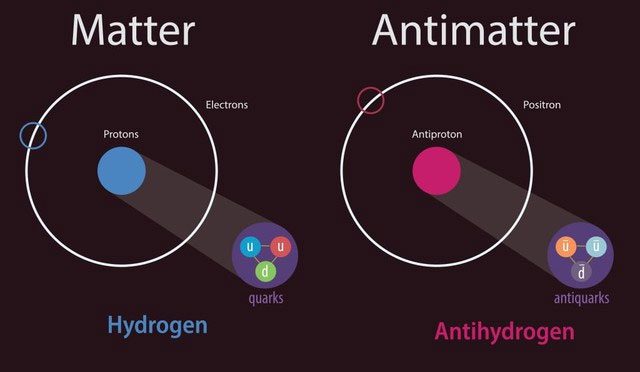Research on antimatter provides profound insights into the symmetry between matter and antimatter, an important aspect of particle physics.
Antimatter has fascinated scientists and science fiction enthusiasts for decades. While it possesses extraordinary properties and has the potential to revolutionize various fields, there is one challenge that has puzzled scientists for years – antimatter has an extremely short lifespan.
So why do scientists continue to create something that almost disappears immediately?
In 1928, physicist Paul Dirac proposed an idea that for every particle of matter in the universe, there must exist a corresponding antimatter particle. However, shortly after the Big Bang, a mysterious cosmic event occurred, leading to the disappearance of most antimatter, leaving behind less than 5% of the matter that constitutes the universe as we know it today.
Introduction to Antimatter
According to modern physics, every particle of matter has a corresponding antiparticle. For example, the antiparticle of an electron is called a positron, which carries a positive charge.
When matter and antimatter particles meet, they annihilate each other, releasing energy in the process.
This annihilation is mathematically described by Einstein’s famous equation, E=mc², where E represents energy, m is mass, and c is the speed of light. The result of this equation is an extremely efficient source of explosive energy.

Illustration of matter and antimatter.
The energy released from matter-antimatter annihilation is far greater than anything achievable through chemical reactions, nuclear fission, or even nuclear fusion. This future energy source has inspired countless stories (of course, in films), from spacecraft propulsion engines to ultimate energy sources.
Theoretically, just a tiny amount of antimatter can produce a colossal amount of energy, making it a potential game-changer in space exploration and energy production on Earth.
The Curious Case of Antihydrogen
The simplest atom in the universe is hydrogen, consisting of one proton and one electron. The antimatter counterpart to this fundamental element is antihydrogen, a neutral atom made up of a positron with a positive charge orbiting an antiproton with a negative charge.
In 1995, physicists at the European Organization for Nuclear Research (CERN) achieved a groundbreaking milestone by successfully creating the first antihydrogen atoms.

Comparison between matter and antimatter.
This was accomplished using the Low Energy Antiproton Ring (LEAR) at CERN. The process involved allowing energetic antiprotons to collide with heavy atomic nuclei, a collision that could produce electron-positron pairs.
After creating a piece of actual antimatter, the essential task for scientists became to hold it for a longer duration. Storing it is challenging but necessary for effectively studying the behavior of this antiparticle.
The solution proposed was the Antiproton Decelerator, established at CERN in the late 1990s, providing slower-moving, lower-energy antiprotons for antimatter experiments. Silicon detectors were used to detect and locate powerful energy bursts, confirming the presence of trapped antihydrogen.
One of the main objectives of the ALPHA experiment at CERN in 2011 was to conduct a precise comparison between hydrogen and antihydrogen to determine whether they share the same spectral lines, a crucial test of the fundamental symmetry between matter and antimatter.
To achieve this, scientists successfully stored antimatter atoms for about 16 minutes. With this new capability to trap antihydrogen for extended periods, researchers now have the opportunity to gain deeper insights into its properties.

Illustration of particle collision at CERN.
Another research effort – the AEGIS experiment – aims to measure the gravitational acceleration constant (g) experienced by antihydrogen atoms. These experiments, along with others, have the potential to unravel the mysteries surrounding antimatter.
So, if creating and storing antimatter is so challenging, why do scientists persist in their efforts?
The answer lies in the pursuit of knowledge and addressing fundamental questions about the universe. Antimatter is not just a potential energy source; it is a fundamental aspect of particle physics and cosmology. It provides insights into the symmetry between matter and antimatter, as well as the enduring mystery of why there is more matter than antimatter in the universe.
Medical Applications and Practical Uses of Antimatter
Antimatter is not only used to power spacecraft; it also has practical and real-world applications! In the field of medicine, positron emission tomography (PET) relies on antimatter. Positrons are used to create images of the human body, aiding in the diagnosis and treatment of various diseases. This medical technology has saved countless lives.
While the idea of antimatter propulsion largely remains theoretical, it is an actively researched field. This concept involves using the energy released from matter-antimatter annihilation as a highly efficient propulsion method for spacecraft.

Antimatter could also be used to propel spacecraft.
In conclusion, the creation and study of antimatter remain a field of deep interest and research in science. Despite its elusive nature and the challenges associated with containment and production, antimatter research promises to provide profound insights into the fundamental nature of the universe.





















































